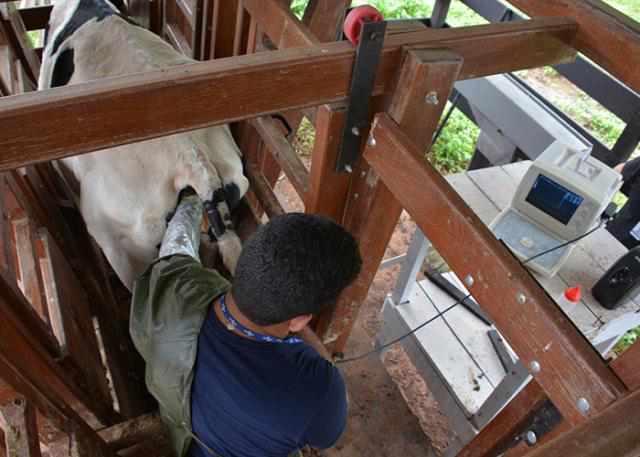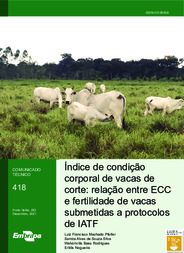Embrapa Rondônia
Research develops method to estimate cow fertility in TAI programs
Photo: Luiz Pfeifer

Index information allows the identification of which animals have higher or lower reproductive potential, which facilitates corrections for the success of the process
|
The Brazilian cattle farmers who use timed artificial insemination (TAI) protocols (also known as fixed-time artificial insemination or FTAI) now have an ally to improve the fertility of their herd. Embrapa developed a body condition score index (BCSi) that offers fast, objective and reliable information about the potential fertility of the animals included in TAI programs. That will enable technicians and farmers to make immediate decisions. To facilitate access to the index, which resulted from a series of mathematical calculations, the researchers made an automated MS Excel spreadsheet, which can be downloaded for free and used in real time in corrals, on a cell phone. The user only needs to insert the body condition score of each cow that will undergo TAI.
A BCSi for beef cattle is unprecedented and establishes a relation between the body condition score (BCS) and the postpartum fertility of beef cows subjected to TAI protocols. The method can identify animals with higher likelihood of pregnancy and offers an assessment of the nutritional condition of the cows that will be included in TAI programs. “The predictability of results and the tools available for farmers are the main advantages of the use of this index in the TAI process, with a focus on the maximum efficiency of the herd”, asserts the Embrapa Rondônia researcher Luiz Pfeifer, who was responsible for creating the index..
The information that the BCSi offers can identify unnecessary expenses in the insemination of animals with lower likelihood of pregnancy, and show the need for investments in nutritional management to improve animal performance. That is because such information clearly demonstrates which animals have higher or lower reproductive potential, which allows for corrections for the success of the process.
Another advantage is that a high BCSi is also associated with the production of more sustainable meat, as farmers will be able to produce more calves with the same inputs through the use of TAI, since calves produced via artificial insemination have higher efficiency than those generated naturally. “The BCSi was developed to help farmers increase herd fertility and hence the potential for exploration in the same area and with the same inputs”, Pfeifer states.
An incentive to TAI
According to the researcher, the systematic use of the index also encourages the use of TAI. That is because the reliable information on nutritional conditions clarifies the points that can compromise the efficiency of this protocol, favoring higher adoption.
In Brazil, TAI has been growing steadily. It is estimated that 22% of the beef cows are inseminated through this process in the country. That figure was about 6% ten years ago. “When the use of the protocol grows, efficiency tends to fall. The new index can help to keep TAI protocol rates high, or even increase them”, the researcher states.
Fast, easy access with reliable information
Studies demonstrate that the cows postpartum body condition score is directly associated with reproductive performance. Cows with a good BCS (between 3 and 4) have higher pregnancy likelihood than females that show a BCS below or above that range. Therefore, a higher reproductive efficiency can be achieved when the BCS assessment is used as a criterion to select heifers with higher likelihood to get pregnant through TAI.
With this, the systematic adoption of this assesment, based not on the average BCS of the herd, but on the individual assessement of the animals, gives objective and and more assertive results of the effect of BCS on the likelihood of pregnancy in cows that participate in TAI protocols.
The relationship between BCSi and fertility were validated in a study performed jointly by Embrapa Rondônia and Embrapa Pantanal. It assessed 31 insemination lots containing over 2,300 animals. In this study, the researchers verified that higher fertility was obtained in lots of cows with better BCSi. The use of this index can help farmers and technicians by providing more precise information on the body condition and fertility of the animals used in reproduction", adds the Embrapa Pantanal researcher Ériklis Nogueira.
Pfeifer explains that, despite the fact a cow with BCS 3, for instance, is able to perform all reproductive functions, fulfilling its role in the production system, the fact a group of cows has an average BCS of 3 does not tell much to the farmer. The average does not translate the individuality of each animal of the group. Pfeifer exemplifies that the average between two animals with BCS of 1 and 5, respectively, is 3. However, none of these two animals is in suitable conditions to reach good fertility rates.
Meanwhile the index the study developed demonstrates that the higher the BCSi, the higher fertility. It considers the extent to which each cow is far from the goal it has to reach. “This is the mathematical formula that is embodied in the spreadsheet we are making available for technicians and farmers. It comprises objective and safe information so that technicians and cattle farmers can make decisions about the herd”, Pfeifer says.
 How to calculate the BCSi
How to calculate the BCSi
To calculate the index, the first step is to assess the individual BCS for all of the cows that will be part of the TAI protocol. This can be made visually, using a BCS scale of 1 to 5 (1 = thin, 5 = fat), with increments of 0.25. This data is enough to be inserted in the spreadsheet that automatically generates the index result. If farmers do not know to assess an animal's BCS, the Vetscore, ruler is a simple tool developed by Embrapa Rondônia that can assist in the identification of animals with suitable BCS. The device is formed by two articulated rulers that should be positioned on top of each animal's rump, and then it indicates its body condition.
In order to use the spreadsheet in real time in the corral, it is important that it downloaded from the Internet. Then it it will be available in the cell phone or computer where it was downloaded for offline access and calculations. Embrapa's research team has been working on the development of an app, for the Android and iOS systems, with the aim of making the access to BCSi calculations more practical, so that it can be systematically used by cattle farmers and give more efficiency to the reproductive system of the property .
Details with step-by-step guidelines used for the elaboration of this index can be accessed in the technical communication available here.
Renata Silva (MTb 12361/MG)
Embrapa Rondônia
Press inquiries
rondonia.imprensa@embrapa.br
Phone number: +55 69 3219-5011
Translation: Mariana Medeiros (13044/DF)
General Secretariat
Further information on the topic
Citizen Attention Service (SAC)
www.embrapa.br/contact-us/sac/

